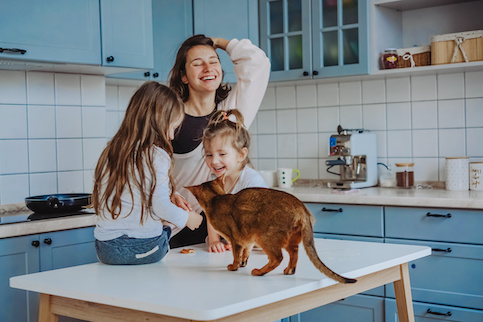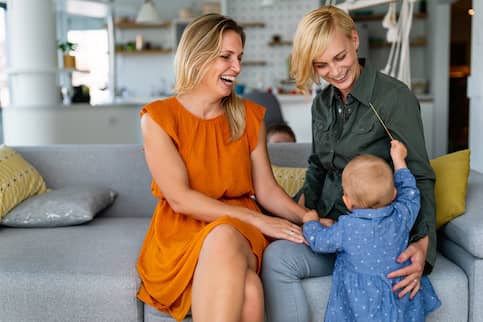A cash-out refinance can be a great option to pay for a home improvement project. That’s especially true if you don’t want to deal with getting a second mortgage loan or paying the typically higher interest rates for a home equity loan, home equity line of credit or personal loan.
While you’re considering the best type of loan to pay for your home renovations, it can be helpful to look at refinancing and which type of mortgage refinance is best for you. A cash-out refinance is the type of mortgage refinance that can help pay for your home improvements. Let’s take a look at how you could use it for your home projects.
How Does Refinancing A Home Loan Work?
Refinancing allows homeowners to take on a new loan with different terms by replacing your current mortgage loan.
Homeowners refinance for a number of different reasons, including to change their mortgage interest rate, to change their loan terms or to use a cash-out refinance to fund renovation projects or cover other large expenses.
How Can You Fund Home Improvements With A Cash-Out Refinance?
A cash-out refi is a type of mortgage refinance that allows you to use the equity you have in your home to get a new mortgage by converting some of your equity into cash.
Essentially, you’re borrowing more than you currently owe on your loan and pocketing the difference. To do this, you need to have enough equity in your home to borrow.
Cash-out refinances are different from second mortgages. When you get a cash-out refi, the new mortgage becomes your primary mortgage.
For example, if you bought your home for $200,000 and have paid off $75,000 of the loan, you still owe $125,000 on your original mortgage. Let’s say the value of your home has increased to $300,000. When you subtract the amount you owe from the current value of your home ($300,000 – $125,000), you get your home equity. In this case, that would be $175,000.
Keep in mind that lenders generally cap the amount you can borrow at around 80% of your home’s value. For this example, your lender would allow you to cash out up to $240,000.
Cash-Out Refinance Requirements
When considering your eligibility for a cash-out refinance, lenders will review a few factors. Let’s look at some of the requirements you need to meet to qualify.
- Credit score: Most lenders require you to have a credit score of at least 620 to qualify for a cash-out refinance. Requirements may vary based on the lender and may be as low as 580 for certain types of loans.
- Debt-to-income ratio: Your DTI is a percentage that represents your fixed monthly debts compared to your gross monthly income. For a cash-out refinance, most lenders require a 43% or lower DTI. Depending on the lender and type of loan, the exact percentage may vary.
- Home equity: You’ll need to have and retain at least 20% equity in your home to refinance. If you have a VA loan, backed by the U.S. Department of Veterans Affairs, you may be able to withdraw up to 100% of the equity in your home, but exact qualifications may vary by lender.
- Home appraisal: Mortgage lenders will likely require a home appraisal as part of the mortgage application process. Getting a new home appraisal before a cash-out refinance helps determine how much your home is actually worth, which impacts the amount of equity you have in your home.
Can You Use A Cash-Out Refinance For Any Home Improvement?
Yes, unlike most home improvement loans, a cash-out refinance allows you to use the money for any home improvement or even for other expenses. Remember that the money you’re borrowing in a cash-out refinance reflects years of monthly payments on your home, so use it wisely. Consider which home improvements and renovations will increase your home’s value.
If your home needs major repairs or updates to electrical, heating or other major systems, consider taking care of those first. If you sell your home later, upgrades to its major components can be highly attractive to potential buyers. Also, certain improvements – such as replacing the roof or HVAC system – may get you discounts on your homeowners insurance premium. Or if you just want to enjoy a new breakfast nook, plan a kitchen remodel and embrace your inner designer.
Should You Use A Refinance As A Home Improvement Loan? The Pros And Cons
If you have a large expense you can’t cover using your savings, a cash-out refinance allows you to access funding from your most valuable asset – your home. Since home improvement projects can often be quite costly, a cash-out refi can make them affordable for you.
Cash-out refinances – like every other type of loan – can come with challenges for borrowers. Deciding if it’s worth it to get one depends on your individual situation.
So, should you do it? Let’s take a look at the pros and cons.
Pros Of Refinancing For A Home Improvement
- Lower interest rates: Because a cash-out refi is your primary loan, you’ll generally be able to get a better rate than with a home equity loan, or HELOC, which is usually a second mortgage you take out on top of your main mortgage. Other loan types, like personal loans, may also carry higher interest rates.
- Higher loan value: You may be able to get more cash with a cash-out refi than with a traditional personal loan, depending on your home’s value and how much equity you hold.
- Potentially lower monthly payments: A cash-out refinance can allow you to pocket more money from your home’s equity and get a lower monthly mortgage payment at the same time. However, this depends on whether or not current mortgage rates are lower than they were when you purchased your home. If they are lower, you may be able to snag a lower rate and lower your payments.
- Rebuild equity: Another advantage of refinancing for home improvement is that you may be able to build back equity relatively quickly if the renovation you’re doing increases your home’s value.
- Tax benefits: Depending on the type of improvement project and your house’s sale price, you may be able to deduct the cost of the improvement from your taxes in the year you sell.
Cons Of Funding A Home Improvement With A Refinance
- Closing costs: You should know that with a cash-out refinance, you’ll have to pay closing costs. You’ll either pay the closing costs upfront or roll them into your new mortgage.
- Potentially higher interest rates: Interest rates for mortgages are all about timing. If you got your initial mortgage when interest rates were low, it’s possible that refinancing could increase your interest rate.
- Potentially higher monthly payments: Similar to your new interest rate, your monthly payments may change. Depending on the loan term, interest rates and the amount you borrow, it’s possible to end up with a higher monthly payment.
What’s Your Goal?
Buy A Home
Discover mortgage options that fit your unique financial needs.

Refinance
Refinance your mortgage to have more money for what matters.
Tap Into Equity
Use your home’s equity and unlock cash to achieve your goals.
Estimate Your Costs And Mortgage Refinance Payments
Before you decide whether to take out any kind of loan, calculate the cost of the project you want to complete. You’ll want to call contractors and get estimates on the work that will need to be done. By knowing exactly how much it’s going to cost and where the money will go, you can determine how much you need to borrow.
Once you know the amount needed for your home improvement, you can determine how changing your mortgage would affect your finances. If your monthly payment goes up, will you be able to afford it? If your interest rate increases, are you willing to pay more interest over the life of the loan? Use our refinance calculator to see what a refinance might cost over the life of your mortgage.
Ready To Refinance?
Get matched with a lender that can help you reach your financial goals.
Which Loan Might Be Best For You?
If you’re still considering your choices, it might help to compare all of your options. The following table lists a range of loan types along with the situations they best cover.
Ways To Finance Home Improvement
| Type Of Loan | Situation |
|---|---|
| Cash-out refinance | You want to make the most of low interest rates. |
| Personal | You need to access money within a short time frame. |
| Home equity | You’d like to get a lump sum but don’t want to refinance. |
| HELOC | You want to finance a series of projects over time. |
| Credit card | You could benefit from a new card with better features. |
The Bottom Line
Before you refinance to remodel, weigh all your options. A cash-out refinance comes with risks, but if you have the equity in your home to pay for a remodel or home improvements, it can come with great rewards.
More from Quicken Loans:
View Your Refinancing Options
Find a refinance lender that will work with your unique financial situation.

Victoria Araj
Victoria Araj is a Staff Writer for Rocket Companies who has held roles in mortgage banking, public relations and more in her 15-plus years of experience. She has a bachelor’s degree in journalism with an emphasis in political science from Michigan State University, and a master’s degree in public administration from the University of Michigan.












